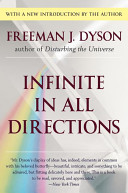Science Communication: Definitions VS Metaphors
A hundred years ago, Charles Darwin could write books discussing the central problems of biology in language which was scientifically precise and still accessible to the general public. In those days the subject matter of biology was plants and animals. The language of Darwin was intelligible to experts and non-experts alike. One did not need a degree in {55} botany to understand the difference between a fern and a flower. Darwin could assume that his readers were familiar with the world of nature as he described it.
Today, unfortunately, the language of Darwin is no longer adequate to describe the main themes of science. The language of physics has moved steadily further into the domain of abstract mathematics. Instead of describing nature with mechanical models, physicists now describe it with infinite-dimensional spaces and other even more esoteric mathematical concepts. And the language of biology has become heavily encrusted with the jargon of chemistry. During the last fifty years, biologists have made enormous progress in understanding the basic processes of life. The basic processes are chemical reactions. The price of progress is a language in which "amino acid," "nucleotide," "protein," "nucleic acid" are the common nouns, "synthesize," "catalyze," "polymerize" the common verbs. The chemistry of living cells is the essence of life. The beauty of their variegated architecture is inescapably tied to the ugliness of chemical terminology. The further we penetrate into the mysteries of their behavior, the longer and the uglier our words become.
Anyone who tries to explain modern science to the general public faces a choice, either to write an elementary textbook with technical terminology carefully defined, or to take refuge in metaphor. I have chosen the latter course. In Chapter 1 I used the metaphor of the rain forest to describe the proliferation of particles and of theoretical models in modern physics. The metaphor is impressionistic, but it is not altogether misleading. It may be more illuminating than an elementary description of the objects, quarks and leptons and hadrons and so forth, which the experts are exploring. If the reader would prefer an elementary textbook, there are plenty available, both in particle physics and in molecular biology. I do not need to write another. I shall use metaphor again to describe the chemical architecture of life. In this way I avoid the multitude of technical definitions which are needed if one names each brick in the structure by its proper name.
Notes:
Folksonomies: science communicatoin
Taxonomies:
/science/chemistry (0.423946)
/science/biology (0.420331)
/science/physics (0.325012)
Keywords:
Definitions VS Metaphors (0.977881 (negative:-0.240764)), general public (0.969776 (positive:0.466022)), basic processes (0.952446 (positive:0.426113)), elementary textbook (0.930898 (positive:0.294863)), esoteric mathematical concepts (0.929946 (neutral:0.000000)), Charles Darwin (0.813588 (positive:0.466022)), language (0.810586 (positive:0.039673)), central problems (0.763940 (positive:0.466022)), Science Communication (0.758778 (neutral:0.000000)), subject matter (0.756213 (neutral:0.000000)), infinite-dimensional spaces (0.754998 (neutral:0.000000)), main themes (0.739965 (negative:-0.376328)), abstract mathematics (0.737984 (neutral:0.000000)), common nouns (0.733685 (neutral:0.000000)), enormous progress (0.732808 (positive:0.533606)), amino acid (0.731773 (neutral:0.000000)), nucleic acid (0.730828 (neutral:0.000000)), mechanical models (0.730266 (negative:-0.394842)), common verbs (0.726327 (neutral:0.000000)), chemical reactions (0.725153 (positive:0.318619)), uglier our words (0.723780 (negative:-0.533096)), elementary description (0.721741 (neutral:0.000000)), chemical terminology (0.718356 (negative:-0.620596)), technical terminology (0.713427 (neutral:0.000000)), rain forest (0.713290 (neutral:0.000000)), modern science (0.708873 (neutral:0.000000)), molecular biology (0.706202 (neutral:0.000000)), chemical architecture (0.705666 (negative:-0.246577)), modern physics (0.704053 (neutral:0.000000)), theoretical models (0.703247 (neutral:0.000000))
Entities:
Charles Darwin:Person (0.889032 (positive:0.100150)), chemical reactions:FieldTerminology (0.525926 (positive:0.390281)), molecular biology:FieldTerminology (0.412237 (neutral:0.000000)), amino acid:FieldTerminology (0.388421 (neutral:0.000000)), hundred years:Quantity (0.388420 (neutral:0.000000)), fifty years:Quantity (0.388420 (neutral:0.000000))
Concepts:
Chemistry (0.948677): dbpedia | freebase | opencyc
Mathematics (0.931651): dbpedia | freebase | opencyc
Standard Model (0.921369): dbpedia | freebase | yago
Physics (0.870140): dbpedia | freebase | opencyc
DNA (0.861086): website | dbpedia | freebase | yago
Science (0.815730): dbpedia | freebase | opencyc
Charles Darwin (0.803645): dbpedia | freebase | opencyc | yago
Biology (0.790365): dbpedia | freebase | opencyc





